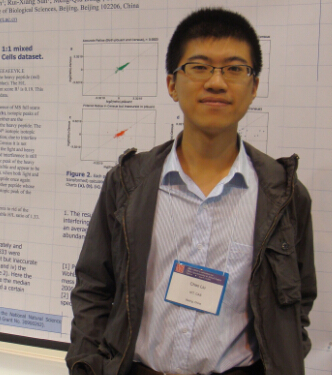特邀专家
截止2016年4月10日,CNCP-2016 组委会已经邀请到来自海内外的26位学者做大会报告(按照姓氏拼音排序):
Discovery and Characterization of Short-chain Lysine Acylations with Mass Spectrometry and Quantitative Proteomics
Abstract: Mass spectrometry-based proteomics analysis has enabled global identification and quantification of protein posttranslational modification pathways. Lysine acetylation is an evolutionarily conserved protein modification that intimately link between cellular metabolism and key regulatory mechanisms such as epigenetic memory and protein-protein interactions. This presentation will review the recent progress in the characterization of lysine acetylation and other novel short-chain lysine acylation pathways in prokaryotic and eukaryotic cells. We will discuss the proteomic analysis strategy and unrestrictive sequence alignment software that we developed for the discovery of posttranslational modifications from tandem mass spectrometry data, which led to the identification of novel short-chain lysine acylation pathways. We will highlight the functional significance of these new lysine modifications with the recent breakthrough studies that revealed the complex crosstalk between cellular metabolic states and epigenetic regulatory mechanisms. To further address the issue of modification prevalence in the cells, we will discuss quantitative strategies to measure the absolute stoichiometries of lysine acylations in cells and the application of the strategy to identify histone site-specific sensitivity to enzymatic inhibitors and environmental chemicals.
Key words: lysine acetylation, short-chain lysine acylation, quantitative proteomics, unrestrictive sequence alignment, stoichiometry analysis
GAPP: a Proteogenomic Software for Genome Annotation and Global Profiling of Post-Translational Modifications in Prokaryotes
Abstract: While the number of sequenced prokaryotic genomes is growing rapidly, experimentally verified annotation of prokaryotic genome remains patchy and challenging. To facilitate genome annotation efforts for prokaryotes, we developed an open source software called GAPP for genome annotation and global profiling of posttranslational modifications (PTMs) in prokaryotes. With a single command, it provides a standard workflow to validate and refine predicted genetic models and discover diverse PTM events. We demonstrated the utility of GAPP using proteomic data from Helicobacter pylori, one of the major human pathogens that is responsible for many gastric diseases. Our results confirmed 82.5% of predicted gene products, identified 40 novel protein coding genes, and corrected four existing gene models with regard to translation initiation sites. In particular, GAPP revealed a large repertoire of PTMs using the same proteomic data and provided a rich resource that can be used to examine the functions of reversible modifications in this human pathogen. This software is a powerful tool for PTM genome annotation and global discovery and is applicable to any sequenced prokaryotic organism; we expect that it will become an integral part of ongoing genome annotation efforts for prokaryotes.
Key words: proteogenomics, genome annotation, posttranslational modifications (PTMs), prokaryotes
Developing Cross-linking Mass Spectrometry (XL-MS) Strategies to Define Interaction and Structural Dynamics of Protein Complexes
Abstract: Protein-protein interactions (PPIs) are fundamental to protein structure and function. Perturbations of PPIs can cause deleterious effects on cellular activities and thus lead to various human diseases. Understanding interaction and structural dynamics of protein complexes is critical to unraveling molecular details that underlie human pathologies. Cross-linking mass spectrometry (XL-MS) has recently become a powerful strategy for delineating PPIs within large multi-subunit protein complexes. However, one of the inherent challenges in MS analysis of cross-linked peptides is their unambiguous identification. To facilitate this process, we have developed a series of sulfoxide-containing MS-cleavable cross-linkers to identify protein interaction interfaces for structural elucidation of protein complexes. These MS-cleavable reagents have allowed us to establish a common robust XL-MS workflow that enables fast and accurate identification of cross-linked peptides using multistage tandem mass spectrometry (MSn). In addition, we have also developed quantitative XL-MS strategies to allow comparative analysis of PPIs and their physical contacts under different physiological conditions. The development of this novel class of MS-cleavable cross-linking reagents and their applications in unraveling interaction and structural dynamics of protein complexes will be presented.
Key words: cross-linking mass spectrometry, protein-protein interactions, protein complexes, quantitative XL-MS
Mite Allergen Diversity Identification by Proteomics Coupling with Pharmacological Testing
Abstract: The most important indoor allergens for humans are house dust mites (HDM). Desensitization therapy by using allergen is the best way to treat allergy. Fourteen Dermatophagoides farinae allergens (Der f 1-3, 6, 7, 10, 11, 13-18, and 22) are reported although more than 30 allergens have been estimated in D. farinae. Seventeen allergens belonging to 12 different groups were identified by a procedure of proteomics combined with two-dimensional immunoblotting from D. farina extracts. Their sequences were determined by Edman degradation, mass spectrometry analysis, and cDNA cloning. Their allergenicities were assayed by enzyme-linked immunosorbent assay inhibition tests, immunoblots, basophil activation test, and skin prick tests. Eight of them are the first report as D. farinae allergens. The procedure of using a proteomic approach combined with a purely discovery approach using sera of patients with broad IgE reactivity profiles to mite allergens was an effective method to investigate a more complete repertoire of D. farinae allergens. The identification of eight new D. farinae allergens will be helpful for HDM allergy diagnosis and therapy, especially for patients without response for HDM major allergens. In addition, the current work significantly extendedthe repertoire of D. farinae allergens.
Key words: Allergen, Mite, Proteomics, Diversity
De Novo Identification and Quantification of Single Amino-Acid Variants in Human Hepatocellular Carcinoma Tissues
Abstract: Onco-proteogenomics research was focused on the discovery of driver mutations. The detection of single amino-acid variants (SAVs) usually depends on single-nucleotide polymorphisms (SNPs) database. Here, we describe a novel method that discovers SAVs at proteome level either independent or dependent of SNPs data. Using mass spectrometry-based de novo sequencing algorithm, peptide-candidates are identified and compared with theoretical protein database to generate SAVs under pairing strategy, which is followed by database re-searching to control false discovery rate. In human hepatocellular carcinoma (HCC) tissues, we can confidently identify and quantify known and novel protein variants at “personalized” level. Such personalized mutational portrait provides a novel access to high-throughput detection of protein variants for individual patients, which may offer the potential for clinical biomarker discovery and mechanistic research.
Key words: single amino-acid variants (SAVs), de novo, proteomics, onco-proteogenomics, human HCC tissues
Orbitrap based Clinical Proteomics for Precision Medicine and Translational Research
Abstract: With the launch of precision medicine initiative by the Chinese government, biomedicine and translational medicine research in China is entering a new era. As the phenotype of genomics, proteomics has great potential value in clinical application, especially in disease prevention, early diagnosis, classification, as well as pathogenesis and drug target discovery, and thus is a vital important part of precision medicine. As the gold standard of proteomics, the technology and performance of Orbitrap ultra-high resolution mass spectrometry grows exponentially in recent years, and thus brings possibility to cross the divide between proteomics research and clinical application: 1) With the accomplishment of a draft map of the human proteome, Orbitrap already made a breakthrough in ultimate sensitivity and analysis efficiency; 2) With the advances of precision MS quantification technology based on DDA, DIA and PRM, the reproducibility and accuracy of proteomics, from biomarker discovery, to verification, and to validation, has been significantly improved; 3) Revolutionary clinical sample digitalizing strategy on Orbitrap laid a foundation for future biobanking and biomarker precision validation; 4) With ice breaking of LDT policy and ultra-low false positive/negative of Orbitrap, real clinical application of proteomics already begins; 5) Integrated life-omics or multi-omics, including genomics, metabolomics and proteomics, will become more and more important in clinical laboratories.
Key words: Orbitrap, clinical Proteomics, precision medicine, translational research
Ultra-Deep Tyrosine Phosphoproteomics Enabled by a Phosphotyrosine Superbinder
Abstract: We present a new strategy for systematic identification of phosphotyrosine (pTyr) by AP-MS using an SH2 domain-derived pTyr-superbinder as the affinity reagent. The superbinder allows for markedly deeper coverage of the Tyr phosphoproteome than anti-pTyr antibodies when an optimal amount is used. Indeed, we identified ~20,000 distinct phosphotyrosyl peptides and >10,000 pTyr sites, of which 36% are novel, from 9 human cell lines using the superbinder approach. Intriguingly, tyrosine kinases, SH2 domains and phosphotyrosine phosphatases were found preferably phosphorylated, suggesting that the toolkit of kinase signaling is subject to intensive regulation by phosphorylation. Cell type-specific global kinase activation patterns inferred from label-free quantitation of Tyr phosphorylation guided the design of experiments to inhibit cancer cell proliferation by blocking the highly activated tyrosine kinases. Therefore, the superbinder is a highly efficient and cost-effective alternative to conventional antibodies for systematic and quantitative characterization of the tyrosine phosphoproteome under normal or pathological conditions.
Key words: tyrosine phosphorylation, pTyr enrichment, Tyrosine Kinase Signaling
Development of the cross-linked peptides identification in large scales
Abstract: Because of the large search space, identifying cross-linked peptides on a proteome scale remains a big challenge. Here we critically examine the performance of more commonly used search engines for the cross-linked peptides identification in large scales, and introduce the novel computing technologies involved. Furthermore, we present next generation structure ion-index, which is designed to substitute the popular open-modification search strategy. Our results show that by using ion-index, pLink 2.0 could complete a search of 5000 spectra against the human database on a workstation within one hour. pLink 2.0 also supports the MS-cleavable cross-linkers, which were proposed by XLinkX. In the comparison of pLink2.0 and other search engines, we find that determining the mono isotopic peak of cross-linked peptide is a critical but neglected by other engines. In addition, we discuss challenges in arriving at fast and accurate interpretations of cross-linking mass spectrometry data in the further.
Key words: proteomics, cross-linking, peptide identification, search engineers
Charting the Cellular Interactome by Proteome-Wide Cross-Linking Mass Spectrometry
Abstract: We established an XL-MS workflow that counteracts the two major difficulties in cross-linking data analysis, i.e., 1) the escalating size of the search space of the database (the n-square problem), and 2) the inefficient fragmentation of either of the two linked peptides. The novel approach comprises three essential features; the use of MS-cleavable cross-linkers, a hybrid MS2-MS3 fragmentation strategy and a dedicated cross-link search engine for data analysis (XlinkX v2.0). We applied the MS-cleavable cross-linker DSSO to be able to determine the precursor mass of each linked peptide moiety by the unique fragmentation pattern of the cross-link in CID MS2 acquisitions, hence successfully solving the n-square problem. Beneficially, these cross-linker-cleaved precursor ions can be specifically targeted in mass-difference-triggered data-dependent MS3 acquisitions, which are enabled in the Oribitrap Fusion and Lumos tribrid instruments. This acquisition strategy substantially increases the successful rate of the MS3 experiments, thus overcoming the problem of inefficient fragmentation and dramatically improving the data quality. In consequence, the hereby developed approach includes the following three significant advancements compared with previous methods: 1) cross-link identification from full proteome database, 2) cross-link identification that includes multiple PTMs as variable modifications, and 3) high quality spectra at both MS2 and MS3 level. We applied this novel XL-MS strategy to several highly complex samples, including E. coli lysate, HeLa lysate, size exclusion chromatography fractionated HeLa cell nuclear extract and intact organelles. We successfully identified thousands to tens of thousands cross-links per sample with high confidence, allowing the proteome-wide characterization of conformations, interactions and spatial arrangements of many endogenous protein complexes in their cellular environment.
Key words: cross-linking mass spectrometry, XlinkX, interactome, MS2, MS3
Opportunities and Challenges for Urinary Biomarker Discovery Using Proteomic Approaches
Abstract: In comparison to other biofluid and tissue samples, urine has some unique advantages that make it a suitable source for disease biomarker discovery. Firstly, urine can be collected continuously and non-invasively. Secondly, urine proteome are mainly composed of plasma proteins that pass the glomerular barrier and secreted or intracellular proteins from cells of renal and urogenital organs, indicating that it contains rich information of the whole body. Analyzed a pooled normal human sample by a three dimensional separation strategy, we recently identified over 6, 000 proteins originated from a broad range of tissues. Thirdly, functioned to excrete body waste, urine proteome composition is not regulated by any mechanism to maintain its homeostasis, which means that changes caused by diseases might be easily discovered in urine. Finally, urine proteome is easier to be identified and quantified by MS-based techniques as compared to plasma, making it possible to perform high throughput and efficient analysis of clinical samples in a reasonable sample size. Due to some intrinsic properties of this biofluid, biomarker discovery in urine is also a challenging work. One major challenge is that urine concentration and composition have strong diurnal and individual variations. Currently there are neither housekeeping molecule nor robust normalization factors could be used in urine studies. Another difficulty is in the study of renal diseases with dysfunction of glomerular filtration. In this cases, high abundant plasma proteins get into urine, causing tremendous alternations of urine proteome composition as well as suppressing the detection of low abundant disease-related proteins. Moreover, the depth of urine proteome analysis still need to be improved, so that to uncover more low abundant proteins originated from the injured tissue.
Key words: urine proteomics, biomarker discovery
Trifunctional Cross-linker for Mapping Protein-Protein Interaction Networks and Comparing Protein Conformational States
Abstract: To improve chemical cross-linking of proteins coupled with mass spectrometry (CXMS), we developed a lysine-targeted enrichable cross-linker containing a biotin tag for affinity purification, a chemical cleavage site to separate cross-linked peptides away from biotin after enrichment, and a spacer arm that can be labeled with stable isotopes for quantitation. By locating the flexible proteins on the surface of 70S ribosome, we show that this trifunctional cross-linker is effective at attaining structural information not easily attainable by crystallography and electron microscopy. From a crude Rrp46 immunoprecipitate, it helped identify two direct binding partners of Rrp46 and 15 protein-protein interactions (PPIs) among the co-immunoprecipitated exosome subunits. Applying it to E. coli and C. elegans lysates, we identified 3130 and 893 inter-linked lysine pairs, representing 677 and 121 PPIs. Using a quantitative CXMS workflow we demonstrate that it can reveal changes in the reactivity of lysine residues due to protein-nucleic acid interaction.
Key words: cross-linking mass spectrometry, protein-protein interactions, protein structures, quantitation
Protein Microarrays for Systems Biology: Construction, Application and Technology Development
Abstract: Our laboratory is majorly focus on protein microarray technology developement and its systematic applications. In this talk I will first introduce how the high-density protein microarray is constructed, and take the newly reported Mycobacterium tuberculosis proteome microarray as an example. I will then discuss how we have applied the human proteome microarray for global identification of arsenic binding proteins. A total of 360 arsenic binding proteins were identified. Functional study revealed that glycolysis is highly targeted by arsenic and the activity of the rate-limiting enzyme of glycolysis, i.e., hexokinase II was inhibited upon arsenic binding. Cutting-edge technology development is always highly demanded for both basic biology and clinical studies. Thus, in the last example, I will discuss the construction of the super high-density antibody microarray, i.e., with 40,000 monoclonal antibodies and its application for fast monoclonal antibody generation in 4 weeks.
Key words: Protein microarray, antibody microarray, Mtb, Arsenic, monoclonal antibody
Proteomics Toolbox for Profiling Intercellular Signaling
Abstract: Cell-cell interactions are often mediated by protein molecules expressed by one cell that are recognized by specific receptors present on neighboring cells. This intercellular communication activates specific signaling pathways through the induction of dynamic posttranslational modifications such as phosphorylation and protein-protein interactions. Mass spectrometry-based proteomics have been proven to be a robust approach for characterizing dynamic protein phosphorylation and interaction on a global scale. However, proteomic studies of signaling networks under conditions with physiological cell-cell contact have been challenging. In this talk, I will present our recent development of unbiased quantitative proteomic approaches toward this end. Our work established several generally applicable and combinatorial strategies for studying cell-cell communication and provided valuable resources for systematically understanding dysfunctional signaling networks in tumor microenvironment in a context closer to physiological condition than was previously possible.
Key words: biological mass spectrometry, proteomics, signal transduction, tumor microenvironment
Mapping Conserved Metazoan Protein Complexes with Biochemical Fractionation and LC/MS/MS
Abstract: Knowledge of multiprotein complexes is essential for understanding of biological processes, but their phylogenetic distribution across species, especially large-scale network mapping is a challenge. We directly examined the composition of soluble multiprotein complexes common to metazoan, by applying high resolution biochemical fractionation and quantitative mass spectrometry to soluble cell extracts from C. elegans, D. melanogaster, M. musculus, S. purpuratus, and Homo sapiens. Using a human-centric integrative computational analysis, we identified 7,699 high confidence protein-protein interactions and 981 putative functional modules encompassing 2,153 broadly-conserved proteins. This interactome presented the core physical underpinnings of the basic macromolecular machinery broadly relevant to metazoan physiology, development and evolution. Clustering revealed metazoan-restricted protein complexes involved in multicellular development and more ancient assemblies that have likely served central cellular housekeeping roles for over 1 billion years. This reconstructed physical interaction network provides mechanistic insights into the unique molecular biology and evolution of animal cells.
Key words: multiprotein complexes, biochemical fractionation, quantitative mass spectrometry
New Chemical Isotope Labeling and Electrospray Ionization Strategies for Intact Proteins Analyses
Abstract: Chemical isotope labeling strategy is widely applied in the proteolytic peptides-based “Bottom-up” proteomic strategy and thousands of proteins could be feasibly quantified in just one experiment. However, the peptides-based proteomic strategy hardly differentiates the different protein isoforms with high accuracy. Recently, the intact proteins-based “Top-down” proteomic strategy has been greatly developed. However, global quantification of intact proteins by using the chemical isotope labeling strategy has not been reported until now. We optimized the stable isotope labeling strategy for intact protein samples, and high labeling efficiency (>95%) was achieved for intact protein samples extracted from cell lines. It was observed that a series of isotopic pairs with different charge states could be observed after mass differentiate isotope labeling for the intact proteins, and the mass difference revealed the numbers of primary amino groups onto the intact proteins, which greatly enhanced the identification confidence. We have realized the quantification of over 1000 intact protein isoforms in just one experiment for the cell line samples under different conditions. Further, we develop an acidic vapor assisted electrospray ionization strategy within an enclosed ionization source to counteract the ion suppression effects caused by trifluoroacetic acid. The signal intensity of intact proteins was improved 10 times with the acidic vapor assistance and the number of valid signals for E. coli intact protein sample was improved 96%.
Key words: chemical isotope labeling, intact proteins analyses, mass spectrometry
Ubiquitously Expressed Genes Participate in Cell Specific Functions via Alternative Promoter Usage
Abstract: How do different cell types acquire their specific identities and functions is a fundamental question of biology. Previously significant efforts have been devoted to search for cell type specifically expressed genes, especially transcription factors, yet how do ubiquitously expressed genes participate in the formation or maintenance of cell type specific features remains largely unknown. Here, we have identified 110 mouse embryonic stem cell (mESC) specifically expressed transcripts with stage-specific alternative transcription start sites (SATS isoforms) from 104 ubiquitously expressed genes (SATS genes), majority of which have active epigenetic modification or stem cell related functions. These SATS isoforms are specifically expressed in mESCs, and tend to be transcriptionally regulated by key pluripotency factors through promoter binding. Knocking down the SATS isoforms of Nmnat2 or Usp7 leads to differentiation related phenotype in mESCs. These results demonstrate that cell type-specific transcription factors are capable to produce cell type-specific transcripts with alternative transcription start sites from ubiquitously expressed genes, thus confer ubiquitously expressed genes novel functions to involve in the establishment or maintenance of cell type-specific features.
Key words: Embryonic stem cell; Pluripotency factors; Stage-specific alternative transcription start sites; Ubiquitously expressed genes
Protein Identification and Quantification based on Multiple Search Engines
Abstract: Protein identification and quantification are basic steps in proteomics study. This presentation will focus on our recent progress in the development of software for protein identification and quantification based on multiple search engines (multi-search strategy). Although there are several software which can be used to combine identification results from multiple search engines using sophisticated algorithms, these software have been not widely used in protein identification and quantification workflow because of some limitations. In order to address these limitations and promote the application of the multi-search strategy to improve the protein identification and quantification, we have developed open access software which utilized sophisticated algorithms and worked with the mzIdentML standard from the Proteomics Standards Initiative (PSI). We will present the performance and application of our software for both protein identification and quantification.
Key words: bioinformatics, protein identification, protein quantification, shotgun proteomics, mass spectrometry
Improving Peptide Identification for Tandem Mass Spectrometry by Incorporating Translatomics Information
Abstract: Mass spectrometry (MS) is one of the most important technologies in proteomic studies, and database search for MS is the method of choice for protein identification. In general, the methods based on database search usually utilize spectral data and ignore other information in biological systems for peptides identification. However, recently the external available information from transcriptome RNA-seq that improve the sensitivity of peptides identification had been verified. And comparing with transcriptome information, the tranlatomics embody out a stronger correlation with protein, thus it may has more powerful effect in peptides identification. In this study, we propose a novel high-sensitivity peptides identification strategy, IPomics, that incorporating with translatomics information as a prior probability for protein identification. And the protein prior probability is integrated into a new match scoring function to adjust the confidence scores of protein identification. IPomics provide more confident protein identifications compared with Mascot and Pfind, and increases the overall peptides identification rate, spectra utilization rate and identified protein from LC-MS/MS datasets with 30%, 40% and 2% in human and 20%, 30% and 10% in rat, respectively. Besides, the novel strategy for creating scoring function with prior probability of translatomics is also suitable for transcriptome, and thus it may contribute largely to the proteome studies by using multiple OMICS information.
Key words: protein identification algorithm, translatomics information, prior probability
Liquid Chromatography-Mass Spectrometry based Metabolomics Strategies Towards Clinical Applications
Abstract: Metabolomics is one of the important platforms of system biology. With the arising of precision medicine, metabolomics is now showing its potential in biomarker discovery, molecular typing and personalized medicine. As the mainstream techniques of metabolomics, liquid chromatography mass spectrometry (LC-MS) can detect and quantify a wide range of metabolites and may be extensive used in the clinic. According to the challenges that impede LC-MS based metabolomics in clinical applications, we are now developing new standard operation procedure (SOP) and strategies to address the issues. To ensure the quality of clinical samples, we studied the procedure of blood sample collection and storage, and established a practical SOP for clinical studies and the constructions of biobank. Large scale samples are always necessary for the discovery and validation of novel biomarkers. We developed a high throughput metabolomics strategy and realized 100 samples/day on a LC-MS. And we also developed methods for the calibration of data in a large sample batch and emerging data from different sample batches. Using these methods, we are now able to perform large scale metabolomics studies (≥1,000 samples) with good data quality. And these methods may expand the applications of metabolomics in the clinic.
Key words: metabolomics, liquid chromatography mass spectrometry, biomarker
Isolation and Structural Analysis of N-Linked Glycans by Using Two-dimensional Chromatography, Mass Spectrometry and Nuclear Magnetic Resonance Spectroscopy
Abstract: For in-depth understanding the biofunctions of glycans attached to proteins, it is the first priority to acquire their structural information. Comprehensive elucidation of glycan structures is usually difficult due to the complexity and heterogeneity of the glycans. Meanwhile, glycan isomers differing in topology, branching or linkage pattern further hinder the structural elucidation. Although tandem mass spectrometry (MS) has become one of the most powerful techniques for glycan structure analysis, the prior chromatographic separation is still indispensable, since the sample complexity could be significantly reduced by using LC. Due to the limited selectivity, single dimensional chromatography was insufficient for the full resolution of highly complex glycopeptides. Herein, an offline two-dimensional hydrophilic interaction chromatographic (HILIC) method was developed for the effective isolation of N-glycans released from model glycoprotein. Taking advantage of the differentiated selectivity of the employed HILIC materials, up to thirty pure N-glycans compounds including isomers were purified, whose molecular masses varied from 1024 to 2120 Da. The structures of these pure glycans were further characterized by using tandem mass spectrometry and NMR spectroscopy, respectively, for the unambiguous assignment of the monosaccharide composition, sequence, branch, linkage as well as anomeric configurations of these glycans.
Key words: N-Glycans, two-dimensional chromatography, HILIC, tandem mass spectrometry, NMR
High-Throughput de novo Proteome Identification Aided by Translatome Sequencing
Abstract: Database search is the primary method for high-throughput proteomic analysis at present. However, the drawback of database search strategy lays on the dependency of a reliable reference database. Therefore it is difficult to identify new peptides, peptides with modifications or with amino acids variations. De novo peptide sequencing circumvents these drawbacks, however it is not practical for high-throughput proteomic analysis due to the lack of appropriate FDR control method. Here, we present a new strategy to use translating mRNA (RNC-mRNA) to serve as a reliable quality control for mRNA. We have tested this strategy on the HCD mass spectra of three hepaocellular carcinoma cell lines Hep3B, MHCC97H, MHCCLM3) and identified 7279, 7562 and 7002 proteins, respectively. Compared with the true positive identification result from conventional database search methods, the new strategy identified 795, 1010 and 914 more proteins. This showed that our new strategy improves peptides identifications, especially identifying the peptides which are difficult for the database search. Therefore, this strategy provides unique power on identifying new peptides and peptides with various alterations.
Key words: de novo sequencing, translatome seqencing
Selection of Tandem Mass Spectra for Identification of Intact N- and O-linked Glycopeptides
Abstract: Glycoproteomics, the high-throughput study of protein glycosylation using mass spectrometry, is a rapidly growing field. Recent advances in instrumentation have facilitated the analysis of intact glycopeptides, which is essential for preserving the information of glycosylation microheterogeneity of glycoproteins. Higher-energy collisional dissociation (HCD) fragmentation of glycopeptides creates various types of fragment ions that carry important information about the structures of their precursors. Oxonium ions are generated from glycan fragmentation and depending on the glycan structure, exhibit different patterns. To identify the glycopeptides to, we developed a computational model to select tandem spectra containing glycans and link the spectra to N- and O-linked glycans based on glycan structures and the intensity distribution of oxonium ions in the MS/MS spectra of glycopeptides. Tandem mass spectra of glycopeptides extracted from known N-linked and O-linked glycoproteins including fetuin, glycophorin A, ovalbumin and gp120 were used to build a spectral database of N- and O-linked glycopeptides. Logistic regression was applied to this database to distinguish between the spectra of N- and O-linked glycopeptides based on the intensity of oxonium ions. Remarkably, spectral features of oxonium ions were found to reliably distinguish between N- and O-linked glycopeptides. Particularly, hexose oxonium ions were shown to be more abundant in the spectra of N-linked glycopeptides, whereas sialic acid ions were more dominant in the spectra of O-linked glycopeptides. Additionally, HexNAc oxonium ions exhibited different spectral patterns between the two types of glycosylation. The developed model facilitates data interpretation of glycopeptides assigned to tandem spectra based on the spectral features of their oxonium ions. This model has been integrated into GPQuest, a software tool for identification of intact glycopeptides in HCD mass spectrometry data. These spectral features were processed in a machine learning approach to predict the glycosylation types of glycopeptides assigned to tandem spectra. Finally, the performance of the developed predictive model in a complex biological sample was evaluated and verified in HILIC enriched glycopeptides extracted from human serum.
Key words: oxonium ions, Glycopeptide identification, N- and O-linked glycans, intact glycopeptide, glycoproteomics
Ionic Liquid Based Sample Preparation Strategy for Efficient Proteome Analysis
Abstract: Despite significant achievements in complete mapping of the human proteome have been reached, the identification efficiency for membrane proteins remained to be improved. In our study, ionic liquid (IL) was applied for the first time to analyze membrane proteins. Compared to other reported methods, ILs offer high solubilizing ability and good compatibility for trypsin digestion and mass spectrometry detection. And then, the interaction between ILs and IMPs was systematically investigated and a membrane protein preparation method using 1-dodecyl-3-methylimidazolium chloride (C12Im-Cl) was developed, which was successfully applied to large-scale membrane proteome analysis and showed superior performance to other additives, such as SDS. Furthermore, based on the strong dissolving ability and good trypsin activity compatibility of C12Im-Cl, a universal sample preparation method, termed i-FASP was developed. This method couples protein extraction with C12Im-Cl, buffer exchange with NH4HCO3 and on-filter digestion to provide high-performance in-depth protein coverage, high throughput and ease of sample preparation. This efficient method improved protein and membrane protein identification in HeLa cell lysates by 15.9% and 29.2%, respectively, over the conventional FASP method, and the analysis time was reduced by four hours. In contrast to the substantial sample loss observed with the FASP method, average of 3,000 proteins was identified by our strategy from 1,000-cell samples. Taking HeLa cell line as a sample, with our method, a more comprehensive dataset of 9,810 gene products was achieved compared to the reported reaching. Notably, 26 gene products in our dataset were annotated to be missing proteins, among which 16 proteins (62%) were predicted to be with transmembrane domains. Therefore, the strategy we developed here can be an extremely effective tool in achieving unprecedented depth of proteome coverage.
Key words: ionic liquid, membrane protein, sample preparation,in-depth proteome analysis
Scaffold Protein-Mediated Dynamic Assembly of Protein Complexes in Normal and Cancer Cells
Abstract: Many classes of cell-surface receptors initiate signal transduction cascade by catalysing the formation of multi-component protein complexes through recruiting its cytoplasmic targets. This process is often mediated by receptor-associated scaffold proteins. Activated receptor tyrosine kinases, for example, frequently engage scaffolds such as Shc1 with phosphotyrosine (pTyr) binding (PTB) domains. However, the biological rationale for the prevalence of such scaffolds remains uncertain. We address this question through an IP-MRM-based method that tracks the spatial and temporal changes of signaling complex mediated by Shc1 following epidermal growth factor receptor (EGFR) activation. We further combine this approach with biochemical and genetic techniques to elaborate in fine details the dynamic nature of EGFR/Shc1 signaling networks, providing molecular explanations to functional outputs of EGF signaling. We find that Shc1 responds to EGF stimulation in a remarkably dynamic manner, involving multiple waves of distinct phosphorylation events and protein interactions. Shc1 successively interacts with an inhibitory protein, a rapidly-binding group of proteins that activate pro-mitogenic/survival pathways dependent on recruitment of the Grb2 adaptor to Shc1 pTyr sites, the Ptpn12 tyrosine phosphatase recruited following Akt-mediated phosphorylation of Shc1, and a sub-network of proteins involved in cytoskeletal re-organization, protein trafficking and signal inhibition that is recruited to Shc1 with delayed kinetics largely through the Sgk269 pseusokinase/adaptor protein. Shc1 is therefore not a simple scaffold, but rather acts as a time sensitive hub that determines the timing with which EGF-induced signaling switches between distinct states. This may be a more general property of scaffolds required for signaling from distinct types of cell surface receptors.
When we applied the IP-MRM-based EGFR/Shc1 complex quantification method to a variety of breast cancer cell lines with different ErbB activation profiles, we find that the protein complex assembly surrounding Shc1 varies significantly between distinct cells. Therefore, the proteomic analysis of EGFR/Shc1 complexes may be diagnostic for pTyr-based oncogenic signaling in breast cancers. Notably, the strategy and methods developed in this study can be applied to other signaling systems such as immune receptors and apoptotic receptors.
Key words: quantitative mass spectrometry, scheduled MRM, dynamic signaling transduction
Investigation of Signaling Pathway Using Data-Independent Acquisition Proteomics
Abstract: Data-independent acquisition (DIA) based quantitative proteomics, such as SWATH-MS, has emerged to be a critical technique, which enables highly consistent quantification and excellent quantification accuracy. DIA data-analysis are based mostly on targeted extraction of quantitative information, which required spectral library built from shotgun proteomics. We developed untargeted analysis strategy, Group-DIA, which outperformed DIA-Umpire in analyzing multiple DIA data files. Next, we used SWATH-MS to quantify dynamic TNFR1 (TNF receptor I) interactions. The TNFR1 complexes were purified using immunoprecipitation and analyzed with SWATH-MS, and SWATH-MS data were analyzed with Group-DIA. About 1,500 proteins were quantified across 18 IP samples, and analysis of protein profiles revealed that the TNFR1 interacting proteins were dynamically recruited to TNFR1. Furthermore, we also enriched phosphopeptides from IP samples using IMAC technique, and employed SWATH-MS to quantify phosphopeptides in IP samples. About 2,000 phosphopeptides were identified in IP samples, and about 1,500 phosphopeptides were quantified across 18 IP samples. SWATH-MS based consistent protein and phosphorylation sites quantification shed light on the complicate regulation mechanism in TNF signaling pathway.
Key words: TNF signaling pathway, Data-independent acquisition, SWATH, quantitative proteomics
Genome-Wide Quantitative Proteomic and Transcriptomic Analysis Reveals Post-Transcriptional Regulation of Mitochondrial Biogenesis in Human Hematopoiesis
Abstract: Advances in sequencing-based genomic profiling present a new challenge of explaining how changes in DNA and RNA are translated into proteins linking genotypes to phenotypes. The developing erythroid cells require highly coordinated gene expression and metabolism, and serve as a unique model in dissecting regulatory events in development and disease. With the genome wide proteome and transcriptome profiling platforms, we compare the protein expression level change from 14,502 genes and mRNA expression level change from 17,127 genes in human primary hematopoietic stem/progenitor cells and lineage-committed erythroid progenitor, and unexpectedly uncover pathways related to mitochondrial biogenesis enhanced through post-transcriptional regulation. Unexpectedly, two principal mitochondrial factors TFAM and PHB2 indispensable for mitochondrial biogenesis are tightly regulated at the post-transcriptional protein level and indispensable for in erythropoiesis. mTORC1 signaling is progressively enhanced to promote translation of mitochondrial proteins during erythroid specification development. Genetic and pharmacological perturbation of mitochondrial or mTORC1 activities impairs erythropoiesis in vitro and in vivo. Our studies support a mechanism for regulation of mitochondrial biogenesis through the mTORC1-mediated protein translation, and may have direct relevance to the hematological defects associated with mitochondrial diseases and aging.
Key words: Genome wide proteomics, quantitative proteomics, post-transcriptional regulation, mitochondrion, Hematopoiesis



























